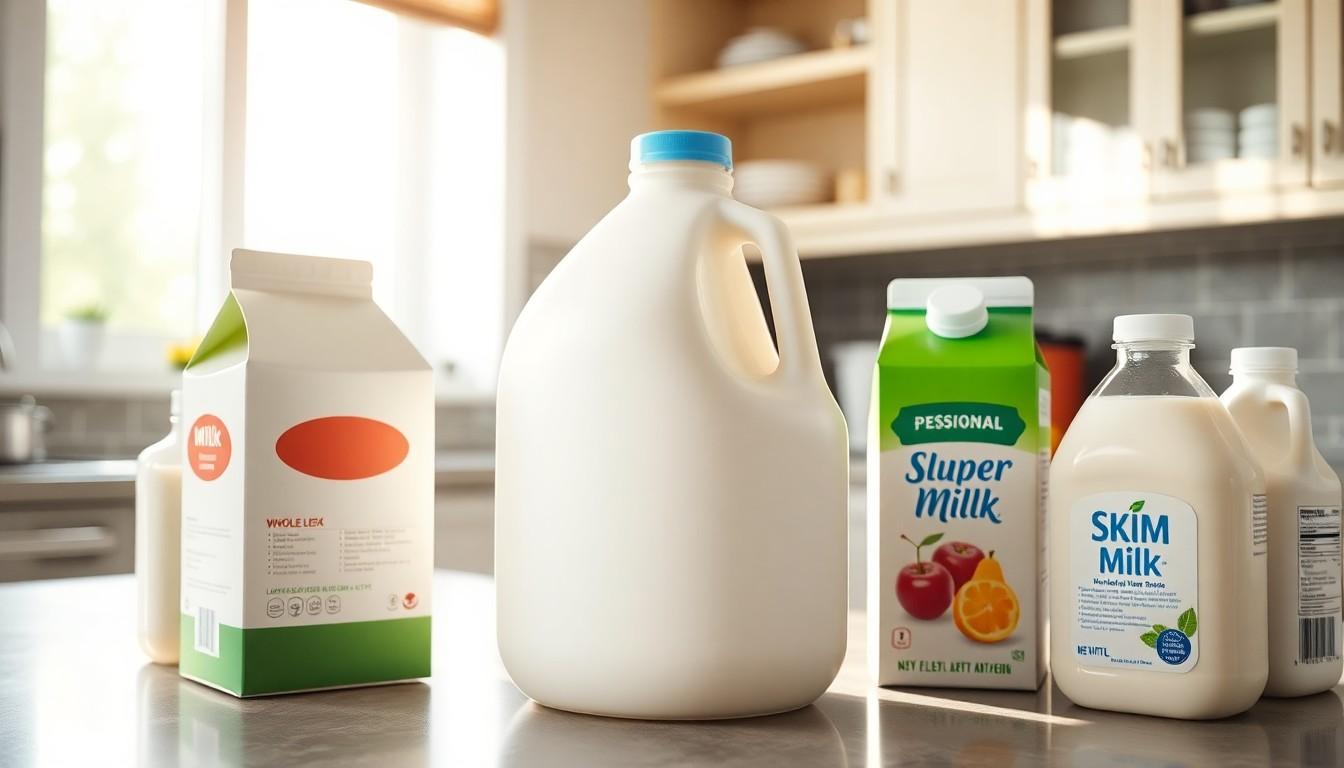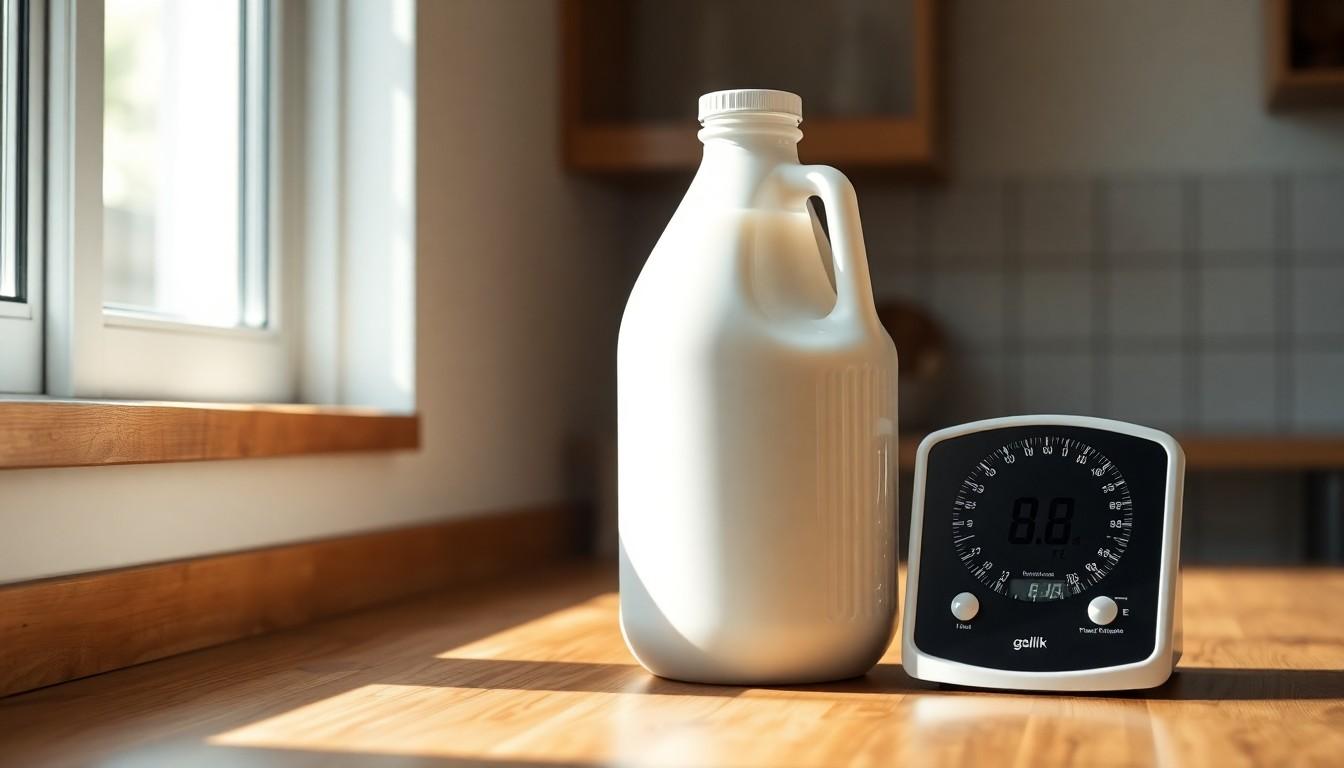Ever wondered how much a gallon of milk actually weighs when you’re lifting it from the grocery shelf? It’s one of those everyday questions that seems simple but has a surprisingly detailed answer. Whether you’re tracking your groceries for a fitness plan or calculating shipping costs, knowing the precise weight of milk can be surprisingly useful.
We’ll jump into the specifics of milk weight and explore why it’s not exactly the same as water even though both being liquids. From whole milk to skim and everything in between, we’ll break down how different types of milk vary in weight due to their fat content. By the end of this article, you’ll have a clear understanding of just how much that gallon jug weighs—and why it matters.
Understanding Milk Weight: How Much Does a Gallon of Milk Weigh?
A gallon of milk typically weighs about 8.6 pounds (3.9 kilograms). This weight varies slightly depending on the type of milk and its fat content. Whole milk, with its higher fat content, weighs approximately 8.6 pounds per gallon, while skim milk weighs slightly less at about 8.5 pounds per gallon.
Fat content directly impacts milk weight because fat is lighter than water. Whole milk contains around 3.25% fat, making it marginally heavier than skim milk with virtually no fat. The difference might seem minimal, but it becomes important when calculating nutritional values or shipping larger quantities.
Temperature also affects milk weight, though the variation is minimal for normal household use. Cold milk from the refrigerator (around 39°F/4°C) weighs slightly more than milk at room temperature (around 68°F/20°C) due to the physical properties of liquids at different temperatures.
For comparison, water weighs about 8.34 pounds (3.78 kilograms) per gallon, making milk approximately 3-4% heavier than water. This difference comes from milk’s additional components like proteins, fats, and minerals that increase its density compared to plain water.
Most commercial milk jugs account for this weight and are designed to be ergonomically carried even though containing nearly 9 pounds of liquid. Understanding milk’s weight helps when planning grocery trips, managing refrigerator space, or calculating shipping costs for dairy products.
The Standard Weight of a Gallon of Milk

A gallon of milk weighs approximately 8.6 pounds (3.9 kilograms), making it slightly heavier than a gallon of water. This standard weight serves as a useful reference point for various applications, from shipping calculations to nutritional planning.
Whole Milk Weight
Whole milk weighs about 8.6 pounds per gallon due to its higher fat content. The additional milk fat contributes to its overall density, which exceeds that of water at 8.34 pounds per gallon. Dairy producers measure this weight precisely to ensure consistent product quality across all packaging sizes. Many consumers don’t realize that milk’s weight comes from a complex mixture of water, proteins, fats, minerals, and other compounds that create its distinctive nutritional profile.
Reduced-Fat Milk Variations
Reduced-fat milk options generally weigh very close to the standard 8.6 pounds per gallon, with minimal variations. The difference between whole milk and reduced-fat varieties is negligible for most practical purposes. Different fat percentages (2%, 1%, or skim) might alter the weight slightly, but these changes are typically too small to impact everyday usage. Commercial dairy processing maintains consistent density across products even though removing varying amounts of fat content.
Factors Affecting Milk Weight

A gallon of milk weighs approximately 8.6 pounds (3.9 kilograms), but several factors can influence this measurement. These variations, while generally minor, come from different components of milk and environmental conditions.
Fat Content Differences
The fat content in milk creates slight weight variations among different milk types. Whole milk typically maintains the standard 8.6 pounds per gallon weight due to its higher fat concentration. Skim milk weighs marginally less at about 8.5 pounds per gallon because fat is actually lighter than water. Milk’s composition includes proteins, minerals, and other components that contribute to its overall density and weight. These compositional elements make milk approximately 3-4% heavier than water, which weighs about 8.34 pounds per gallon. Dairy producers carefully measure these weight specifications to ensure product consistency across various packaging sizes.
Temperature Considerations
Temperature has a negligible impact on the weight of milk, contrary to what some might expect. The standard weight of 8.6 pounds remains consistent regardless of temperature fluctuations. This stability occurs because weight measures mass rather than volume or density, which can change with temperature. Cold milk from the refrigerator weighs essentially the same as milk at room temperature, though its density might vary slightly. Professional dairy handlers account for these minimal temperature-related density changes during processing and packaging, but consumers don’t need to consider this factor when handling milk at home.
Converting Milk Weight to Different Measurements

Knowing how to convert milk weight between different measurement systems helps with recipe calculations, shipping considerations, and international communication. Here’s how to convert a gallon of milk’s weight across various units.
Pounds to Kilograms
Converting milk weight from pounds to kilograms requires a simple multiplication using the standard conversion factor. A gallon of milk weighs 8.6 pounds, which equals approximately 3.9 kilograms when converted. The conversion process uses the standard rate where one pound equals 0.453592 kilograms (8.6 pounds × 0.453592 = 3.9 kilograms). This conversion proves useful when communicating milk weight in countries using the metric system or when following recipes that specify ingredients in metric measurements.
Volume to Weight Relationships
Volume and weight measurements for milk aren’t directly interchangeable due to milk’s unique density properties. A standard gallon of milk contains 128 fluid ounces by volume, but this translates to 8.6 pounds in weight. Milk’s density exceeds that of water, which explains why a gallon of milk outweighs a gallon of water (8.3 pounds) by approximately 0.3 pounds. This density difference results from milk’s composition of fats, proteins, and minerals suspended in water. Understanding this volume-to-weight relationship helps accurately measure milk for cooking, baking, and other applications where precise measurements matter.
Practical Applications of Knowing Milk Weight

Understanding the weight of milk offers important practical benefits in various industries and everyday situations. At 8.6 pounds per gallon (3.9 kilograms), milk’s weight impacts many logistics and dietary considerations.
Shipping and Transportation Considerations
The weight of milk plays a crucial role in transportation logistics across the dairy supply chain. Accurate weight calculations prevent vehicle overloading, ensuring compliance with transportation regulations and maintaining safety standards on the road. Carriers transporting large milk quantities must factor in that each gallon adds 8.6 pounds to their cargo weight, which directly affects fuel consumption and vehicle performance.
Fuel efficiency correlates strongly with cargo weight, making precise milk weight measurements essential for route planning and cost management. Transportation companies often calculate total shipment weight based on the number of milk gallons to optimize delivery routes and minimize fuel expenses.
Logistics professionals use milk weight data to maximize storage capacity in warehouses and delivery vehicles. Knowing that a standard pallet of milk gallons weighs substantially more than water helps prevent structural damage to storage facilities and ensures proper weight distribution during transportation.
Nutritional Calculations
Milk’s density creates important distinctions for nutritional analyses and recipe development. With milk weighing approximately 3-4% more than water (8.6 pounds versus 8.3 pounds per gallon), this difference matters for precise culinary applications and dietary tracking.
Commercial kitchens and food manufacturers rely on accurate milk weight measurements when scaling recipes. The weight-to-volume relationship ensures consistent product quality, especially in baked goods where milk’s density affects texture and moisture content.
Nutritional labeling benefits from understanding milk’s weight properties. Food scientists calculate exact serving sizes based on milk’s weight rather than volume alone, providing consumers with more accurate nutritional information. Dietitians and fitness professionals frequently convert between volume and weight measurements when creating meal plans that include dairy products.
Conclusion
Now that we’ve explored the fascinating details behind milk’s weight we hope you understand why a gallon of milk weighs about 8.6 pounds (3.9 kg). This knowledge proves valuable in many scenarios from kitchen measurements to shipping logistics.
Remember that fat content creates slight variations with whole milk weighing more than skim milk. Though temperature has minimal impact the composition of proteins fats and minerals makes milk approximately 3-4% heavier than water.
Whether you’re calculating nutritional information planning transportation logistics or simply satisfying your curiosity we’ve provided the comprehensive answer to this seemingly simple question. Next time you lift that gallon from your refrigerator you’ll appreciate the science behind its weight!
Frequently Asked Questions
How much does a gallon of milk weigh?
A gallon of milk typically weighs about 8.6 pounds (3.9 kilograms). This weight can vary slightly depending on the type of milk and its fat content, but for most practical purposes, 8.6 pounds is the standard weight you can expect when lifting a gallon of milk from your grocery store shelf.
Does the type of milk affect its weight?
Yes, the type of milk does affect its weight, though the differences are slight. Whole milk weighs approximately 8.6 pounds per gallon, while skim milk weighs about 8.5 pounds. This difference occurs because fat is actually lighter than water, so milk with higher fat content has minimal weight variations that are typically negligible for everyday use.
Why is milk heavier than water?
Milk is approximately 3-4% heavier than water because it contains additional components. While water weighs about 8.34 pounds per gallon, milk’s weight of 8.6 pounds comes from its complex composition that includes proteins, fats, minerals, and sugars suspended in water. These additional nutrients contribute to milk’s higher density and weight compared to plain water.
Does temperature affect milk’s weight?
Temperature has a negligible impact on milk’s weight. While liquids can experience minor density changes with temperature fluctuations, the standard weight of milk (approximately 8.6 pounds per gallon) remains consistent regardless of whether it’s cold from the refrigerator or at room temperature. Any variations are too minimal to matter for everyday purposes.
How do I convert milk weight from pounds to kilograms?
To convert the weight of milk from pounds to kilograms, simply divide the pound value by 2.2046. For a gallon of milk weighing 8.6 pounds, the calculation would be: 8.6 pounds ÷ 2.2046 = approximately 3.9 kilograms. This conversion is useful for international recipes, shipping calculations, or communicating with people using the metric system.
How many fluid ounces are in a gallon of milk?
A standard gallon of milk contains 128 fluid ounces by volume. This volumetric measurement translates to the 8.6 pounds in weight. Understanding this volume-to-weight relationship is important because milk’s density differs from water due to its composition of fats, proteins, and minerals, making accurate measurements crucial for cooking and baking.
Why is knowing milk’s weight important for shipping?
Knowing milk’s weight is crucial for shipping and transportation logistics because it ensures compliance with weight regulations and optimizes fuel efficiency. Accurate weight calculations enable proper route planning and cost management throughout the dairy supply chain. For commercial transportation, even small weight miscalculations can lead to significant cost overruns or regulatory issues.
How does milk weight matter for nutritional calculations?
Milk weight matters for nutritional calculations because precise measurements ensure recipe consistency and accurate nutritional labeling. In commercial kitchens and food manufacturing, exact weights are essential for maintaining product quality. For dietitians and fitness professionals, understanding milk’s weight properties helps create effective meal plans that include the correct portions of dairy products.

